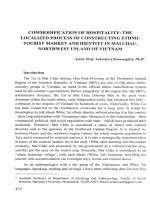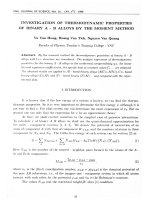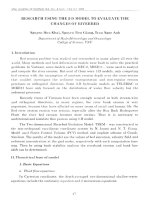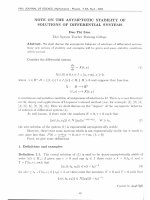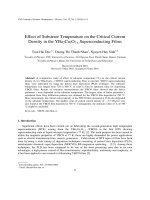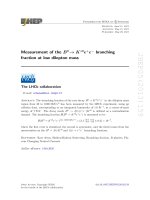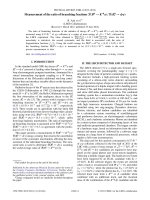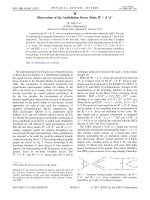DSpace at VNU: Measurements of the branching fractions of the decays B s 0→ D s ∓ K± and B s 0→ D s - π +
Bạn đang xem bản rút gọn của tài liệu. Xem và tải ngay bản đầy đủ của tài liệu tại đây (686.94 KB, 10 trang )
Eur. Phys. J. C (2013) 73:2462
DOI 10.1140/epjc/s10052-013-2462-2
Regular Article - Experimental Physics
Measurements of the branching fractions of B + → p pK
¯ + decays
The LHCb Collaboration
CERN, 1211 Geneva 23, Switzerland
Received: 27 March 2013 / Revised: 16 May 2013 / Published online: 13 June 2013
© CERN for the benefit of the LHCb collaboration 2013. This article is published with open access at Springerlink.com
Abstract The branching fractions of the decay B + →
p pK
¯ + for different intermediate states are measured using
data, corresponding to an integrated luminosity of 1.0 fb−1 ,
collected by the LHCb experiment. The total branching fraction, its charmless component (Mpp¯ < 2.85 GeV/c2 ) and
the branching fractions via the resonant cc¯ states ηc (1S) and
ψ(2S) relative to the decay via a J /ψ intermediate state are
¯ + )total
B(B + → p pK
+
B(B → J /ψK + → p pK
¯ +)
= 4.91 ± 0.19 (stat) ± 0.14 (syst),
B(B + → p pK
¯ + )Mpp¯ <2.85 GeV/c2
B(B + → J /ψK + → p pK
¯ +)
= 2.02 ± 0.10 (stat) ± 0.08 (syst),
B(B + → ηc (1S)K + → p pK
¯ +)
B(B + → J /ψK + → p pK
¯ +)
= 0.578 ± 0.035 (stat) ± 0.027 (syst),
B(B + → ψ(2S)K + → p pK
¯ +)
B(B + → J /ψK + → p pK
¯ +)
= 0.080 ± 0.012 (stat) ± 0.009 (syst).
Upper limits on the B + branching fractions into the ηc (2S)
meson and into the charmonium-like states X(3872) and
X(3915) are also obtained.
1 Introduction
¯ + decay1 offers a clean environment to
The B + → p pK
study cc¯ states and charmonium-like mesons that decay to
p p¯ and excited Λ¯ baryons that decay to pK
¯ + , and to search
1 The inclusion of charge-conjugate modes is implied throughout the
paper.
e-mail:
for glueballs or exotic states. The presence of p p¯ in the final
state allows intermediate states of any quantum numbers to
be studied and the existence of the charged kaon in the final state significantly enhances the signal to background ratio in the selection procedure. Measurements of intermediate
charmonium-like states, such as the X(3872), are important
to clarify their nature [1, 2] and to determine their partial
width to p p,
¯ which is crucial to predict the production rate
of these states in dedicated experiments [3]. BaBar and Belle
have previously measured the B + → p pK
¯ + branching fraction, including contributions from the J /ψ and ηc (1S) intermediate states [4, 5]. The data sample, corresponding to
an integrated luminosity of 1.0 fb−1 , collected by LHCb
√
at s = 7 TeV allows the study of substructures in the
B + → p pK
¯ + decays with a sample ten times larger than
those available at previous experiments.
In this paper we report measurements of the ratios of
branching fractions
R(mode) =
B(B + → mode → p pK
¯ +)
,
B(B + → J /ψK + → p pK
¯ +)
(1)
where “mode” corresponds to the intermediate ηc (1S),
ψ(2S), ηc (2S), χc0 (1P ), hc (1P ), X(3872) or X(3915)
states, together with a kaon.
2 Detector and software
The LHCb detector [6] is a single-arm forward spectrometer covering the pseudorapidity range 2 < η < 5, designed
for the study of particles containing b or c quarks. The detector includes a high precision tracking system consisting
of a silicon-strip vertex detector surrounding the pp interaction region, a large-area silicon-strip detector located upstream of a dipole magnet with a bending power of about
4 Tm, and three stations of silicon-strip detectors and straw
drift-tubes placed downstream. The combined tracking system has momentum (p) resolution p/p that varies from
0.4 % at 5 GeV/c to 0.6 % at 100 GeV/c, and impact parameter resolution of 20 µm for tracks with high transverse
Page 2 of 10
momentum (pT ). Charged hadrons are identified using two
ring-imaging Cherenkov (RICH) detectors. Photon, electron
and hadron candidates are identified by a calorimeter system consisting of scintillating-pad and pre-shower detectors,
an electromagnetic calorimeter and a hadronic calorimeter.
Muons are identified by a system composed of alternating
layers of iron and multiwire proportional chambers.
The trigger [7] consists of a hardware stage, based on information from the calorimeter and muon systems, followed
by a software stage where candidates are fully reconstructed.
The hardware trigger selects hadrons with high transverse
energy in the calorimeter. The software trigger requires a
two-, three- or four-track secondary vertex with a high pT
sum of the tracks and a significant displacement from the
primary pp interaction vertices (PVs). At least one track
should have pT > 1.7 GeV/c and impact parameter (IP) χ 2
with respect to the primary interaction greater than 16. The
IP χ 2 is defined as the difference between the χ 2 of the PV
reconstructed with and without the considered track. A multivariate algorithm is used for the identification of secondary
vertices consistent with the decay of a b hadron.
¯ + decays, generated uniformly in
Simulated B + → p pK
phase space, are used to optimize the signal selection and
to evaluate the ratio of the efficiencies for each considered
channel with respect to the J /ψ channel. Separate sam¯ + and B + → ηc (1S)K + →
ples of B + → J /ψK + → p pK
p pK
¯ + decays, generated with the known angular distributions, are used to check the dependence of the efficiency ratio on the angular distribution. In the simulation, pp collisions are generated using P YTHIA 6.4 [8] with a specific
LHCb configuration [9]. Decays of hadronic particles are
described by E VT G EN [10] in which final state radiation is
generated by P HOTOS [11]. The interaction of the generated
particles with the detector and its response are implemented
using the G EANT 4 toolkit [12, 13] as described in Ref. [14].
3 Candidate selection
Candidate B + → p pK
¯ + decays are reconstructed from any
combination of three charged tracks with total charge of
+1. The final state particles are required to have a track
fit with a χ 2 /ndf < 3 where ndf is the number of degrees of freedom. They must also have p > 1500 MeV/c,
pT > 100 MeV/c, and IP χ 2 > 1 with respect to any primary vertex in the event. Particle identification (PID) requirements, based on the RICH detector information, are
applied to p and p¯ candidates. The discriminating variables
between different particle hypotheses (π , K, p) are the differences between log-likelihood values ln Lαβ under particle hypotheses α and β, respectively. The p and p¯ candidates are required to have ln Lpπ > −5. The reconstructed
B + candidates are required to have an invariant mass in the
Eur. Phys. J. C (2013) 73:2462
range 5079–5579 MeV/c2 . The asymmetric invariant mass
range around the nominal B + mass is designed to select
¯ + candidates without any requirement on
also B + → p pπ
the PID of the kaon. The PV associated to each B + candidate is defined to be the one for which the B + candidate has
the smallest IP χ 2 . The B + candidate is required to have
a vertex fit with a χ 2 /ndf < 12 and a distance greater than
3 mm, a χ 2 for the flight distance greater than 500, and an
IP χ 2 < 10 with respect to the associated PV. The maximum
distance of closest approach between daughter tracks has to
be less than 0.2 mm. The angle between the reconstructed
momentum of the B + candidate and the B + flight direction
(θfl ) is required to have cos θfl > 0.99998.
The reconstructed candidates that meet the above criteria are filtered using a boosted decision tree (BDT) algorithm [15]. The BDT is trained with a sample of simulated
¯ + signal candidates and a background sample
B + → p pK
of data candidates taken from the invariant mass sidebands
in the ranges 5080–5220 MeV/c2 and 5340–5480 MeV/c2 .
The variables used by the BDT to discriminate between signal and background candidates are: the pT of each reconstructed track; the sum of the daughters’ pT ; the sum of the
IP χ 2 of the three daughter tracks with respect to the primary vertex; the IP of the daughter, with the highest pT ,
with respect to the primary vertex; the number of daughters
with pT > 900 GeV/c; the maximum distance of closest approach between any two of the B + daughter particles; the IP
of the B + candidate with respect to the primary vertex; the
distance between primary and secondary vertices; the θfl angle; the χ 2 /ndf of the secondary vertex; a pointing variable
defined as P sinPθ+sin θ p , where P is the total momentum
i T,i
of the three-particle final state, θ is the angle between the
direction of the sum of the daughter’s momentum and the
direction of the flight distance of the B + and i pT,i is the
sum of the transverse momenta of the daughters; and the log
likelihood difference for each daughter between the assumed
PID hypothesis and the pion hypothesis. The selection criterion on the BDT response (Fig. 1) is chosen in order to have
a signal to background ratio of the order of unity. This corresponds to a BDT response value of −0.11. The efficiency
of the BDT selection is greater than 92 % with a background
rejection greater than 86 %.
4 Signal yield determination
The signal yield is determined from an unbinned extended
maximum likelihood fit to the invariant mass of selected
¯ + candidates, shown in Fig. 2(a). The signal
B + → p pK
component is parametrized as the sum of two Gaussian functions with the same mean and different widths. The background component is parametrized as a linear function. The
signal yield of the charmless component is determined by
Eur. Phys. J. C (2013) 73:2462
Fig. 1 Distribution of the BDT algorithm response evaluated for background candidates from the data sidebands (red hatched area), and
signal candidates from simulation (blue filled area). The dotted line
(black) indicates the chosen BDT response value (Color figure online)
Fig. 2 Invariant mass distribution of (a) all selected B + → p pK
¯ +
candidates and (b) candidates having Mpp¯ < 2.85 GeV/c2 . The points
with error bars are the data and the solid lines are the result of the fit.
The dotted lines represent the two Gaussian functions (red) and the
dashed line the linear function (green) used to parametrize the signal
and the background, respectively. The vertical lines (black) indicate
the signal region. The two plots below the mass distributions show the
pulls (Color figure online)
Page 3 of 10
performing the same fit described above to the sample of
¯ + candidates with Mpp¯ < 2.85 GeV/c2 , shown
B + → p pK
in Fig. 2(b). The B + mass and widths, evaluated with the
¯ + candidates,
invariant mass fits to all of the B + → p pK
are compatible with the values obtained for the charmless
component.
The signal yields for the charmonium contributions,
¯ + → p pK
¯ + , are determined by fitting the
B + → (cc)K
¯ + candidates
p p¯ invariant mass distribution of B + → p pK
+
within the B mass signal window, |MppK
¯ + − MB + | <
50 MeV/c2 . Simulations show that no narrow structures are
induced in the p p¯ spectrum as kinematic reflections of pos¯ + intermediate states.
sible B + → p Λ¯ → p pK
An unbinned extended maximum likelihood fit to the p p¯
invariant mass distribution, shown in Fig. 3, is performed
over the mass range 2400–4500 MeV/c2 . The signal components of the narrow resonances J /ψ, ψ(2S), hc (1P ), and
X(3872), whose natural widths are much smaller than the
p p¯ invariant mass resolution, are parametrized by Gaussian
functions. The signal components for the ηc (1S), χc0 (1P ),
ηc (2S), and X(3915) are parametrized by Voigtian functions.2 Since the p p¯ invariant mass resolution is approximately constant in the explored range, the resolution parameters for all resonances, except the ψ(2S), are fixed to the
J /ψ value (σJ /ψ = 8.9 ± 0.2 MeV/c2 ). The background
2
shape is parametrized as f (M) = ec1 M+c2 M where c1 and
c2 are fit parameters. The J /ψ and ψ(2S) resolution parameters, the mass values of the ηc (1S), J /ψ, and ψ(2S)
states, and the ηc (1S) natural width are left free in the fit.
The masses and widths for the other signal components are
fixed to the corresponding world averages [16]. The p p¯ invariant mass resolution, determined by the fit to the ψ(2S)
is σψ(2S) = 7.9 ± 1.7 MeV/c2 .
The fit result is shown in Fig. 3. Figures 4 and 5 show
the details of the fit result in the regions around the ηc (1S)
and J /ψ, ηc (2S) and ψ(2S), χc0 (1P ) and hc (1P ), and
X(3872) and X(3915) resonances. Any bias introduced by
the inaccurate description of the tails of the ηc (1S), J /ψ
and ψ(2S) resonances is taken into account in the systematic uncertainty evaluation.
The contribution of cc¯ → p p¯ from processes other than
¯ + decays, denoted as “non-signal”, is estimated
B + → p pK
from a fit to the p p¯ mass in the B + mass sidebands 5130–
5180 and 5380–5430 MeV/c2 . Except for the J /ψ mode,
no evidence of a non-signal contribution is found. The nonsignal contribution to the J /ψ signal yield in the B + mass
window is 43 ± 11 candidates and is subtracted from the
number of J /ψ signal candidates.
The signal yields, corrected for the non-signal contribution, are reported in Table 1. For the intermediate charmonium states ηc (2S), χc0 (1P ), hc (1P ), X(3872) and
2 A Voigtian function is the convolution of a Breit-Wigner function with
a Gaussian distribution.
Page 4 of 10
Eur. Phys. J. C (2013) 73:2462
Fig. 3 Invariant mass distribution of the p p¯ system for
¯ + candidates within the B + mass signal window,
B + → p pK
|M(p pK
¯ + ) − MB + | < 50 MeV/c2 . The dotted lines represent the
Gaussian and Voigtian functions (red) and the dashed line the smooth
function (green) used to parametrize the signal and the background,
respectively. The bottom plot shows the pulls (Color figure online)
Fig. 5 Invariant mass distribution of the p p¯ system in the regions
around (a) the χc0 (1P ) and hc and (b) the X(3872) and X(3915)
states. The dotted lines represent the Gaussian and Voigitian functions (red) and the dashed line the smooth function (green) used to
parametrize the signal and the background, respectively. The two plots
below the mass distribution show the pulls (Color figure online)
Table 1 Signal yields for the different channels and corresponding
95 % CL upper limits for modes with less than 3σ statistical significance. For the J /ψ mode, the non-signal yield is subtracted. Uncertainties are statistical only
B + decay mode
Signal yield Upper limit (95 % CL)
p pK
¯ + [total]
6951 ± 176
p pK
¯ + [Mpp¯ < 2.85 GeV/c2 ] 3238 ± 122
J /ψK +
856 ± 46
ψ(2S)K +
107 ± 16
ηc (2S)K +
39 ± 15
<65.4
χc0 (1P )K +
15 ± 13
<38.1
21 ± 11
<40.2
ηc
Fig. 4 Invariant mass distribution of the p p¯ system in the regions
around (a) the ηc (1S) and J /ψ and (b) the ηc (2S) and ψ(2S)
states. The dotted lines represent the Gaussian and the Voigtian functions (red) and the dashed line the smooth function (green) used to
parametrize the signal and the background, respectively. The two plots
below the mass distribution show the pulls (Color figure online)
X(3915), there is no evidence of signal. The 95 % CL upper
limits on the number of candidates are shown in Table 1 and
1458 ± 42
(1S)K +
hc
(1P )K +
X(3872)K +
−9 ± 8
<10.3
X(3915)K +
13 ± 17
<42.1
are determined from the likelihood profile integrating over
the nuisance parameters. Since for the X(3872) the fitted
signal yield is negative, the upper limit has been calculated
Eur. Phys. J. C (2013) 73:2462
Page 5 of 10
integrating the likelihood only in the physical region of a
signal yield greater than zero.
5 Efficiency determination
The ratio of branching fractions is calculated using
R(mode) =
=
B(B + → mode → p pK
¯ +)
+
+
B(B → J /ψK → p pK
¯ +)
Nmode
×
NJ /ψ
J /ψ
,
(2)
mode
where Nmode and NJ /ψ are the signal yields for the given
mode and the reference mode, B + → J /ψK + → p pK
¯ +,
and mode / J /ψ is the corresponding ratio of efficiencies.
The efficiency is the product of the reconstruction, trigger,
and selection efficiencies, and is estimated using simulated
data samples.
Since the track multiplicity distribution for simulated
events differs from that observed in data, simulated candidates are assigned a weight so that the weighted distribution
reproduces the observed multiplicity distribution. The distributions of ln LKπ and ln Lpπ for kaons and protons in
data are obtained in bins of momentum, pseudorapidity and
number of tracks from control samples of D ∗+ → D 0 (→
K − π + )π + decays for kaons and Λ → pπ − decays for protons, which are then used on a track-by-track basis to correct the simulation. The efficiency as a function of Mpp¯ is
shown in Fig. 6. A linear fit to the efficiency distribution is
performed and the efficiency ratios are determined based on
the fit result.
Fig. 6 Efficiency as a function of Mpp¯ for B + → p pK
¯ + decays.
The solid line represents the linear fit to the efficiency distribution;
the dashed line is the point-by-point interpolation used to estimate the
systematic uncertainty
shape parametrization and the subtraction of the cc¯ contribution from the continuum. The systematic uncertainty associated with the parametrization of the signal tails of the
J /ψ, ηc (1S) and ψ(2S) resonances is taken into account by
taking the difference between the number of candidates in
the observed distribution and the number of candidates calculated from the integral of the fit function in the range −6σ
to −2.5σ . The systematic uncertainty associated with the selection procedure is estimated by changing the value of the
BDT selection to −0.03, which retains 85 % of the signal
with a 30 % background, and is found to be negligible. The
contributions to the systematic uncertainties from the different sources are listed in Table 2. The total systematic uncertainty is determined by adding the individual contributions
in quadrature.
6 Systematic uncertainties
The measurements of the relative branching fractions depend on the ratios of signal yields and efficiencies with respect to the reference mode. Since the final state is the same
in all cases, most of the systematic uncertainties cancel. The
systematic uncertainty on the efficiency ratio, in each region of p p¯ invariant mass, is determined from the difference between the efficiency ratios calculated using the solid
fitted line and the dashed point-by-point interpolation shown
in Fig. 6. The uncertainty associated with the evaluation of
the B + signal yield has been determined by varying the fit
range by ±30 MeV/c2 , using a single Gaussian instead of a
double Gaussian function to model the signal PDF, and using an exponential function to model the background. For
each charmonium resonance the systematic uncertainty on
the signal yield has been investigated by varying the B mass
signal window by ±10 MeV/c2 , the signal and background
7 Results
The results are summarized in Table 3 and the values of the
product of branching fractions derived from our measurement using the world average values B(B + → J /ψK + ) =
¯ = (2.17 ±
(1.013 ± 0.034) × 10−3 and B(J /ψ → p p)
0.07) × 10−3 [16] are listed in Table 4. The branching
fractions obtained are compatible with the world average
values [16]. The upper limit on B(B + → χc0 (1P )K + →
p pK
¯ + ) is compatible with the world average B(B + →
χc0 (1P )K + ) × B(χc0 (1P ) → p p)
¯ = (0.030 ± 0.004) ×
10−6 [16]. We combine our upper limit for X(3872) with the
known value for B(B + → X(3872)K + ) × B(X(3872) →
J /ψπ + π − ) = (8.6 ± 0.8) × 10−6 [16] to obtain the limit
B(X(3872) → p p)
¯
< 2.0 × 10−3 .
B(X(3872) → J /ψπ + π − )
Page 6 of 10
Table 2 Relative systematic
uncertainties (in %) on the
relative branching fractions
from different sources. The total
systematic uncertainty is
determined by adding the
individual contributions in
quadrature
Eur. Phys. J. C (2013) 73:2462
Source
R(total)
R(Mpp¯ < 2.85 GeV/c2 )
R(ηc (1S))
Efficiency ratio
0.21
0.5
3.3
B + mass fit range
0.16
0.5
–
Sig. and Bkg. shape
2.5
3.6
1.8
6.5
B+
mass window
–
0.6
0.6
0.9
3.8
–
–
0.4
5.1
Signal tail param.
1.0
1.0
1.2
4.3
Total
2.8
3.8
4.1
11.3
R(ηc (2S))
Efficiency ratio
B + mass fit range
R(χc0 (1P ))
4.4
–
Sig. and Bkg. shape
R(hc (1P ))
2.5
R(X(3872))
3.4
–
R(X(3915))
6.5
–
7.0
–
3.9
3.3
14.3
5.6
10.1
B + mass window
11.3
23.6
23.6
17.5
7.5
Non-signal component
–
–
–
–
Signal tail param.
Total
–
1.0
1.0
1.0
1.0
1.0
12.8
24.0
27.8
19.5
15.5
B + → (mode)
→ p pK
¯ +
Yield
± stat ± syst
mode / J /ψ
± syst
J /ψK +
1458 ± 42 ± 24
–
1
–
total
6951 ± 176 ± 171
0.970 ± 0.002
4.91 ± 0.19 ± 0.14
–
Mpp¯ < 2.85 GeV/c2
3238 ± 122 ± 121
1.097 ± 0.006
2.02 ± 0.10 ± 0.08
–
(1S)K +
856 ± 46 ± 19
1.016 ± 0.034
0.578±0.035±0.026
–
ψ(2S)K +
107 ± 16 ± 13
0.921 ± 0.044
0.080±0.012±0.009
–
(2S)K +
39 ± 15 ± 5
0.927 ± 0.041
0.029±0.011±0.004
<0.048
χc0 (1P )K +
15 ± 13 ± 4
0.957 ± 0.024
0.011±0.009±0.003
<0.028
(1P )K +
21 ± 11 ± 5
0.943 ± 0.032
0.015±0.008±0.004
<0.029
X(3872)K +
−9 ± 8 ± 2
0.896 ± 0.058
−0.007±0.006±0.002
<0.008
X(3915)K +
13 ± 17 ± 5
0.890 ± 0.062
0.010±0.013±0.002
<0.032
B + decay mode
B(B + → (mode) → p pK
¯ +)
ηc
ηc
hc
Table 4 Branching fractions
for B + → (mode) → p pK
¯ +
derived using the world average
value of the B(B + → J /ψK + )
¯ branching
and B(J /ψ → p p)
fractions [16]. For the
charmonium modes we compare
our values to the product of the
independently measured
branching fractions. The first
uncertainties are statistical, the
second systematic in the present
measurement, and the third
systematic from the uncertainty
on the J /ψ branching fraction
4.8
Non-signal component
Source
Table 3 Signal yields,
efficiency ratios, ratios of
branching fractions and
corresponding upper limits
R(ψ(2S))
(×106 )
ηc
(1S)K +
UL (95 % CL)
(×106 )
GeV/c2
Upper Limit
95 % CL
Previous measurements
(×106 ) [4, 5]
10.76+0.36
−0.33 ± 0.70
10.81 ± 0.42 ± 0.30 ± 0.49
total
Mpp¯ < 2.85
R(mode)
± stat ± syst
4.46 ± 0.21 ± 0.18 ± 0.20
5.12 ± 0.31
1.27 ± 0.08 ± 0.05 ± 0.06
1.54 ± 0.16
ψ(2S)K +
0.175 ± 0.027 ± 0.020 ± 0.008
ηc (2S)K +
0.063 ± 0.025 ± 0.009 ± 0.003
<0.106
χc0 (1P )K +
0.024 ± 0.021 ± 0.006 ± 0.001
<0.062
hc (1P )K +
0.034 ± 0.018 ± 0.008 ± 0.002
<0.064
0.176 ± 0.012
X(3872)K +
−0.015 ± 0.013 ± 0.003 ± 0.001
<0.017
X(3915)K +
0.022 ± 0.029 ± 0.004 ± 0.001
<0.071
0.030 ± 0.004
Eur. Phys. J. C (2013) 73:2462
Page 7 of 10
This limit challenges some of the predictions for the molecular interpretations of the X(3872) state and is approaching the range of predictions for a conventional χc1 (2P )
state [17, 18]. Using our result and the ηc (2S) branch¯ =
ing fraction B(B + → ηc (2S)K + ) × B(ηc (2S) → K Kπ)
+2.3
−6
(3.4 −1.6 ) × 10 [16], a limit of
B(ηc (2S) → p p)
¯
< 3.1 × 10−2
¯
B(ηc (2S) → K Kπ)
MinES, Rosatom, RFBR and NRC “Kurchatov Institute” (Russia);
MinECo, XuntaGal and GENCAT (Spain); SNSF and SER (Switzerland); NAS Ukraine (Ukraine); STFC (United Kingdom); NSF (USA).
We also acknowledge the support received from the ERC under FP7.
The Tier1 computing centres are supported by IN2P3 (France), KIT
and BMBF (Germany), INFN (Italy), NWO and SURF (The Netherlands), PIC (Spain), GridPP (United Kingdom). We are thankful for
the computing resources put at our disposal by Yandex LLC (Russia),
as well as to the communities behind the multiple open source software
packages that we depend on.
Open Access This article is distributed under the terms of the Creative Commons Attribution License which permits any use, distribution, and reproduction in any medium, provided the original author(s)
and the source are credited.
is obtained.
8 Summary
Based on a sample of 6951 ± 176 B + → p pK
¯ + decays reconstructed in a data sample, corresponding to an integrated
luminosity of 1.0 fb−1 , collected with the LHCb detector,
the following relative branching fractions are measured
¯ + )total
B(B + → p pK
+
B(B → J /ψK + → p pK
¯ +)
= 4.91 ± 0.19 (stat) ± 0.14 (syst),
B(B + → p pK
¯ + )Mpp¯ <2.85 GeV/c2
B(B + → J /ψK + → p pK
¯ +)
= 2.02 ± 0.10 (stat) ± 0.08 (syst),
B(B + → ηc (1S)K + → p pK
¯ +)
B(B + → J /ψK + → p pK
¯ +)
= 0.578 ± 0.035 (stat) ± 0.025 (syst),
B(B + → ψ(2S)K + → p pK
¯ +)
B(B + → J /ψK + → p pK
¯ +)
= 0.080 ± 0.012 (stat) ± 0.009 (syst).
+
+
+)
→X(3872)K →p pK
¯
An upper limit on the ratio B(B
B(B + →J /ψK + →ppK
¯ +)
0.017 is obtained, from which a limit of
<
B(X(3872) → p p)
¯
< 2.0 × 10−3
B(X(3872) → J /ψπ + π − )
is derived.
Acknowledgements We express our gratitude to our colleagues in
the CERN accelerator departments for the excellent performance of
the LHC. We thank the technical and administrative staff at the LHCb
institutes. We acknowledge support from CERN and from the national agencies: CAPES, CNPq, FAPERJ and FINEP (Brazil); NSFC
(China); CNRS/IN2P3 and Region Auvergne (France); BMBF, DFG,
HGF and MPG (Germany); SFI (Ireland); INFN (Italy); FOM and
NWO (The Netherlands); SCSR (Poland); ANCS/IFA (Romania);
References
1. N. Brambilla et al., Heavy quarkonium: progress, puzzles, and opportunities. Eur. Phys. J. C 71, 1534 (2011). arXiv:1010.5827
2. R. Aaij et al. (LHCb Collaboration), Determination of the X(3872)
meson quantum numbers. arXiv:1302.6269
3. J.S. Lange et al., Prospects for X(3872) detection at Panda. AIP
Conf. Proc. 1374, 549 (2011). arXiv:1010.2350
4. B. Aubert et al. (BaBar Collaboration), Measurement of the
¯ + branching fraction and study of the decay dynamB + → p pK
ics. Phys. Rev. D 72, 051101 (2005). arXiv:hep-ex/0507012
5. J. Wei et al. (Belle Collaboration), Study of B + → p pK
¯ + and
B+ → p pπ
¯ + . Phys. Lett. B 659, 80 (2008). arXiv:0706.4167
6. J. Alves, A. Augusto et al. (LHCb Collaboration), The LHCb detector at the LHC. J. Instrum. 3, S08005 (2008)
7. R. Aaij et al., The LHCb trigger and its performance. J. Instrum.
8, P04022 (2013). arXiv:1211.3055 [hep-ex]
8. T. Sjöstrand, S. Mrenna, P. Skands, PYTHIA 6.4 physics and manual. J. High Energy Phys. 05, 026 (2006). arXiv:hep-ph/0603175
9. I. Belyaev et al., Handling of the generation of primary events
in G AUSS, the LHCb simulation framework, in Nuclear Science
Symposium Conference Record (NSS/MIC) (IEEE, New York,
2010), p. 1155
10. D.J. Lange, The EvtGen particle decay simulation package. Nucl.
Instrum. Methods A 462, 152 (2001)
11. P. Golonka, Z. Was, PHOTOS Monte Carlo: a precision tool for
QED corrections in Z and W decays. Eur. Phys. J. C 45, 97 (2006).
arXiv:hep-ph/0506026
12. J. Allison et al. (GEANT4 Collaboration), Geant4 developments
and applications. IEEE Trans. Nucl. Sci. 53, 270 (2006)
13. S. Agostinelli et al. (GEANT4 Collaboration), GEANT4: a simulation toolkit. Nucl. Instrum. Methods A 506, 250 (2003)
14. M. Clemencic et al., The LHCb simulation application, G AUSS:
design, evolution and experience. J. Phys. Conf. Ser. 331, 032023
(2011)
15. L. Breiman, J.H. Friedman, R.A. Olshen, C.J. Stone, Classification and Regression Trees (Wadsworth International Group, Belmont, 1984)
16. J. Beringer et al. (Particle Data Group), Review of Particle Physics
(RPP). Phys. Rev. D 86, 010001 (2012)
17. G. Chen, J. Ma, Production of X(3872) at PANDA. Phys. Rev. D
77, 097501 (2008). arXiv:0802.2982
18. E. Braaten, An estimate of the partial width for X(3872) into p p.
¯
Phys. Rev. D 77, 034019 (2008). arXiv:0711.1854
Page 8 of 10
Eur. Phys. J. C (2013) 73:2462
The LHCb Collaboration
R. Aaij38 , C. Abellan Beteta33,n , A. Adametz11 , B. Adeva34 , M. Adinolfi43 , C. Adrover6 , A. Affolder49 , Z. Ajaltouni5 ,
J. Albrecht9 , F. Alessio35 , M. Alexander48 , S. Ali38 , G. Alkhazov27 , P. Alvarez Cartelle34 , A.A. Alves Jr22,35 , S. Amato2 , Y. Amhis7 , L. Anderlini17,f , J. Anderson37 , R. Andreassen57,s , R.B. Appleby51 , O. Aquines Gutierrez10 , F. Archilli18 ,
A. Artamonov32 , M. Artuso53 , E. Aslanides6 , G. Auriemma22,m , S. Bachmann11 , J.J. Back45 , C. Baesso54,q , V. Balagura28 ,
W. Baldini16 , R.J. Barlow51 , C. Barschel35 , S. Barsuk7 , W. Barter44 , Th. Bauer38 , A. Bay36 , J. Beddow48 , I. Bediaga1 , S. Belogurov28 , K. Belous32 , I. Belyaev28 , E. Ben-Haim8 , M. Benayoun8 , G. Bencivenni18 , S. Benson47 , J. Benton43 , A. Berezhnoy29 , R. Bernet37 , M.-O. Bettler44 , M. van Beuzekom38 , A. Bien11 , S. Bifani12 , T. Bird51 , A. Bizzeti17,h , P.M. Bjørnstad51 , T. Blake35 , F. Blanc36 , C. Blanks50 , J. Blouw11 , S. Blusk53 , A. Bobrov31 , V. Bocci22 , A. Bondar31 , N. Bondar27 ,
W. Bonivento15 , S. Borghi51 , A. Borgia53 , T.J.V. Bowcock49 , E. Bowen37 , C. Bozzi16 , T. Brambach9 , J. van den Brand39 ,
J. Bressieux36 , D. Brett51 , M. Britsch10 , T. Britton53 , N.H. Brook43 , H. Brown49 , I. Burducea26 , A. Bursche37 , J. Buytaert35 ,
S. Cadeddu15 , O. Callot7 , M. Calvi20,j , M. Calvo Gomez33,n , A. Camboni33 , P. Campana18,35 , A. Carbone14,c , G. Carboni21,k , R. Cardinale19,i , A. Cardini15 , H. Carranza-Mejia47 , L. Carson50 , K. Carvalho Akiba2 , G. Casse49 , M. Cattaneo35 ,
Ch. Cauet9 , M. Charles52 , Ph. Charpentier35 , P. Chen3,36 , N. Chiapolini37 , M. Chrzaszcz23 , K. Ciba35 , X. Cid Vidal34 ,
G. Ciezarek50 , P.E.L. Clarke47 , M. Clemencic35 , H.V. Cliff44 , J. Closier35 , C. Coca26 , V. Coco38 , J. Cogan6 , E. Cogneras5 , P. Collins35 , A. Comerma-Montells33 , A. Contu15,52 , A. Cook43 , M. Coombes43 , S. Coquereau8 , G. Corti35 , B. Couturier35 , G.A. Cowan36 , D. Craik45 , S. Cunliffe50 , R. Currie47 , C. D’Ambrosio35 , P. David8 , P.N.Y. David38 , I. De Bonis4 , K. De Bruyn38 , S. De Capua51 , M. De Cian37 , J.M. De Miranda1 , L. De Paula2 , W. De Silva57,s , P. De Simone18 ,
D. Decamp4 , M. Deckenhoff9 , H. Degaudenzi36,35 , L. Del Buono8 , C. Deplano15 , D. Derkach14 , O. Deschamps5 , F. Dettori39 , A. Di Canto11 , J. Dickens44 , H. Dijkstra35 , M. Dogaru26 , F. Domingo Bonal33,n , S. Donleavy49 , F. Dordei11 ,
A. Dosil Suárez34 , D. Dossett45 , A. Dovbnya40 , F. Dupertuis36 , R. Dzhelyadin32 , A. Dziurda23 , A. Dzyuba27 , S. Easo46,35 ,
U. Egede50 , V. Egorychev28 , S. Eidelman31 , D. van Eijk38 , S. Eisenhardt47 , U. Eitschberger9 , R. Ekelhof9 , L. Eklund48 ,
I. El Rifai5 , Ch. Elsasser37 , D. Elsby42 , A. Falabella14,e , C. Färber11 , G. Fardell47 , C. Farinelli38 , S. Farry12 , V. Fave36 , D. Ferguson47 , V. Fernandez Albor34 , F. Ferreira Rodrigues1 , M. Ferro-Luzzi35 , S. Filippov30 , C. Fitzpatrick35 , M. Fontana10 ,
F. Fontanelli19,i , R. Forty35 , O. Francisco2 , M. Frank35 , C. Frei35 , M. Frosini17,f , S. Furcas20 , E. Furfaro21 , A. Gallas Torreira34 , D. Galli14,c , M. Gandelman2 , P. Gandini52 , Y. Gao3 , J. Garofoli53 , P. Garosi51 , J. Garra Tico44 , L. Garrido33 , C. Gaspar35 , R. Gauld52 , E. Gersabeck11 , M. Gersabeck51 , T. Gershon45,35 , Ph. Ghez4 , V. Gibson44 , V.V. Gligorov35 , C. Göbel54,q ,
D. Golubkov28 , A. Golutvin50,28,35 , A. Gomes2 , H. Gordon52 , M. Grabalosa Gándara5 , R. Graciani Diaz33 , L.A. Granado
Cardoso35 , E. Graugés33 , G. Graziani17 , A. Grecu26 , E. Greening52 , S. Gregson44 , O. Grünberg55,r , B. Gui53 , E. Gushchin30 ,
Yu. Guz32 , T. Gys35 , C. Hadjivasiliou53 , G. Haefeli36 , C. Haen35 , S.C. Haines44 , S. Hall50 , T. Hampson43 , S. HansmannMenzemer11 , N. Harnew52 , S.T. Harnew43 , J. Harrison51 , P.F. Harrison45 , T. Hartmann55,r , J. He7 , V. Heijne38 , K. Hennessy49 , P. Henrard5 , J.A. Hernando Morata34 , E. van Herwijnen35 , E. Hicks49 , D. Hill52 , M. Hoballah5 , C. Hombach51 ,
P. Hopchev4 , W. Hulsbergen38 , P. Hunt52 , T. Huse49 , N. Hussain52 , D. Hutchcroft49 , D. Hynds48 , V. Iakovenko41 , P. Ilten12 , R. Jacobsson35 , A. Jaeger11 , E. Jans38 , F. Jansen38 , P. Jaton36 , F. Jing3 , M. John52 , D. Johnson52 , C.R. Jones44 ,
B. Jost35 , M. Kaballo9 , S. Kandybei40 , M. Karacson35 , T.M. Karbach35 , I.R. Kenyon42 , U. Kerzel35 , T. Ketel39 , A. Keune36 , B. Khanji20 , O. Kochebina7 , I. Komarov36,29 , R.F. Koopman39 , P. Koppenburg38 , M. Korolev29 , A. Kozlinskiy38 ,
L. Kravchuk30 , K. Kreplin11 , M. Kreps45 , G. Krocker11 , P. Krokovny31 , F. Kruse9 , M. Kucharczyk20,23,j , V. Kudryavtsev31 ,
T. Kvaratskheliya28,35 , V.N. La Thi36 , D. Lacarrere35 , G. Lafferty51 , A. Lai15 , D. Lambert47 , R.W. Lambert39 , E. Lanciotti35 , G. Lanfranchi18,35 , C. Langenbruch35 , T. Latham45 , C. Lazzeroni42 , R. Le Gac6 , J. van Leerdam38 , J.-P. Lees4 ,
R. Lefèvre5 , A. Leflat29,35 , J. Lefrançois7 , O. Leroy6 , Y. Li3 , L. Li Gioi5 , M. Liles49 , R. Lindner35 , C. Linn11 , B. Liu3 ,
G. Liu35 , J. von Loeben20 , J.H. Lopes2 , E. Lopez Asamar33 , N. Lopez-March36 , H. Lu3 , J. Luisier36 , H. Luo47 , F. Machefert7 ,
I.V. Machikhiliyan4,28 , F. Maciuc26 , O. Maev27,35 , S. Malde52 , G. Manca15,d , G. Mancinelli6 , N. Mangiafave44 , U. Marconi14 , R. Märki36 , J. Marks11 , G. Martellotti22 , A. Martens8 , L. Martin52 , A. Martín Sánchez7 , M. Martinelli38 , D. Martinez Santos39 , D. Martins Tostes2 , A. Massafferri1 , R. Matev35 , Z. Mathe35 , C. Matteuzzi20 , M. Matveev27 , E. Maurice6 ,
A. Mazurov16,30,35,e , J. McCarthy42 , R. McNulty12 , B. Meadows57,52,s , F. Meier9 , M. Meissner11 , M. Merk38 , D.A. Milanes8 ,
M.-N. Minard4 , J. Molina Rodriguez54,q , S. Monteil5 , D. Moran51 , P. Morawski23 , R. Mountain53 , I. Mous38 , F. Muheim47 ,
K. Müller37 , R. Muresan26 , B. Muryn24 , B. Muster36 , P. Naik43 , T. Nakada36 , R. Nandakumar46 , I. Nasteva1 , M. Needham47 ,
N. Neufeld35 , A.D. Nguyen36 , T.D. Nguyen36 , C. Nguyen-Mau36,o , M. Nicol7 , V. Niess5 , R. Niet9 , N. Nikitin29 , T. Nikodem11 , S. Nisar56,s , A. Nomerotski52 , A. Novoselov32 , A. Oblakowska-Mucha24 , V. Obraztsov32 , S. Oggero38 , S. Ogilvy48 ,
O. Okhrimenko41 , R. Oldeman15,35,d , M. Orlandea26 , J.M. Otalora Goicochea2 , P. Owen50 , B.K. Pal53 , A. Palano13,b ,
M. Palutan18 , J. Panman35 , A. Papanestis46 , M. Pappagallo48 , C. Parkes51 , C.J. Parkinson50 , G. Passaleva17 , G.D. Patel49 , M. Patel50 , G.N. Patrick46 , C. Patrignani19,i , C. Pavel-Nicorescu26 , A. Pazos Alvarez34 , A. Pellegrino38 , G. Penso22,l ,
Eur. Phys. J. C (2013) 73:2462
Page 9 of 10
M. Pepe Altarelli35 , S. Perazzini14,c , D.L. Perego20,j , E. Perez Trigo34 , A. Pérez-Calero Yzquierdo33 , P. Perret5 , M. PerrinTerrin6 , G. Pessina20 , K. Petridis50 , A. Petrolini19,i , A. Phan53 , E. Picatoste Olloqui33 , B. Pietrzyk4 , T. Pilaˇr45 , D. Pinci22 ,
S. Playfer47 , M. Plo Casasus34 , F. Polci8 , G. Polok23 , A. Poluektov45,31 , E. Polycarpo2 , D. Popov10 , B. Popovici26 , C. Potterat33 , A. Powell52 , J. Prisciandaro36 , V. Pugatch41 , A. Puig Navarro36 , W. Qian4 , J.H. Rademacker43 , B. Rakotomiaramanana36 , M.S. Rangel2 , I. Raniuk40 , N. Rauschmayr35 , G. Raven39 , S. Redford52 , M.M. Reid45 , A.C. dos Reis1 , S. Ricciardi46 , A. Richards50 , K. Rinnert49 , V. Rives Molina33 , D.A. Roa Romero5 , P. Robbe7 , E. Rodrigues51 , P. Rodriguez Perez34 ,
G.J. Rogers44 , S. Roiser35 , V. Romanovsky32 , A. Romero Vidal34 , J. Rouvinet36 , T. Ruf35 , H. Ruiz33 , G. Sabatino22,k ,
J.J. Saborido Silva34 , N. Sagidova27 , P. Sail48 , B. Saitta15,d , C. Salzmann37 , B. Sanmartin Sedes34 , M. Sannino19,i , R. Santacesaria22 , C. Santamarina Rios34 , E. Santovetti21,k , M. Sapunov6 , A. Sarti18,l , C. Satriano22,m , A. Satta21 , M. Savrie16,e ,
D. Savrina28,29 , P. Schaack50 , M. Schiller39 , H. Schindler35 , S. Schleich9 , M. Schlupp9 , M. Schmelling10 , B. Schmidt35 ,
O. Schneider36 , A. Schopper35 , M.-H. Schune7 , R. Schwemmer35 , B. Sciascia18 , A. Sciubba18,l , M. Seco34 , A. Semennikov28 , K. Senderowska24 , I. Sepp50 , N. Serra37 , J. Serrano6 , P. Seyfert11 , M. Shapkin32 , I. Shapoval40,35 , P. Shatalov28 ,
Y. Shcheglov27 , T. Shears49,35 , L. Shekhtman31 , O. Shevchenko40 , V. Shevchenko28 , A. Shires50 , R. Silva Coutinho45 ,
T. Skwarnicki53 , N.A. Smith49 , E. Smith52,46 , M. Smith51 , K. Sobczak5 , M.D. Sokoloff57,s , F.J.P. Soler48 , F. Soomro18,35 ,
D. Souza43 , B. Souza De Paula2 , B. Spaan9 , A. Sparkes47 , P. Spradlin48 , F. Stagni35 , S. Stahl11 , O. Steinkamp37 , S. Stoica26 ,
S. Stone53 , B. Storaci37 , M. Straticiuc26 , U. Straumann37 , V.K. Subbiah35 , S. Swientek9 , V. Syropoulos39 , M. Szczekowski25 ,
P. Szczypka36,35 , T. Szumlak24 , S. T’Jampens4 , M. Teklishyn7 , E. Teodorescu26 , F. Teubert35 , C. Thomas52 , E. Thomas35 ,
J. van Tilburg11 , V. Tisserand4 , M. Tobin37 , S. Tolk39 , D. Tonelli35 , S. Topp-Joergensen52 , N. Torr52 , E. Tournefier4,50 ,
S. Tourneur36 , M.T. Tran36 , M. Tresch37 , A. Tsaregorodtsev6 , P. Tsopelas38 , N. Tuning38 , M. Ubeda Garcia35 , A. Ukleja25 ,
D. Urner51 , U. Uwer11 , V. Vagnoni14 , G. Valenti14 , R. Vazquez Gomez33 , P. Vazquez Regueiro34 , S. Vecchi16 , J.J. Velthuis43 ,
M. Veltri17,g , G. Veneziano36 , M. Vesterinen35 , B. Viaud7 , D. Vieira2 , X. Vilasis-Cardona33,n , A. Vollhardt37 , D. Volyanskyy10 , D. Voong43 , A. Vorobyev27 , V. Vorobyev31 , C. Voß55,r , H. Voss10 , R. Waldi55,r , R. Wallace12 , S. Wandernoth11 ,
J. Wang53 , D.R. Ward44 , N.K. Watson42 , A.D. Webber51 , D. Websdale50 , M. Whitehead45 , J. Wicht35 , J. Wiechczynski23 ,
D. Wiedner11 , L. Wiggers38 , G. Wilkinson52 , M.P. Williams45,46 , M. Williams50,p , F.F. Wilson46 , J. Wishahi9 , M. Witek23 ,
S.A. Wotton44 , S. Wright44 , S. Wu3 , K. Wyllie35 , Y. Xie47,35 , F. Xing52 , Z. Xing53 , Z. Yang3 , R. Young47 , X. Yuan3 ,
O. Yushchenko32 , M. Zangoli14 , M. Zavertyaev10,a , F. Zhang3 , L. Zhang53 , W.C. Zhang12 , Y. Zhang3 , A. Zhelezov11 ,
L. Zhong3 , A. Zvyagin35
1 Centro
Brasileiro de Pesquisas Físicas (CBPF), Rio de Janeiro, Brazil
Federal do Rio de Janeiro (UFRJ), Rio de Janeiro, Brazil
3 Center for High Energy Physics, Tsinghua University, Beijing, China
4 LAPP, Université de Savoie, CNRS/IN2P3, Annecy-Le-Vieux, France
5 Clermont Université, Université Blaise Pascal, CNRS/IN2P3, LPC, Clermont-Ferrand, France
6 CPPM, Aix-Marseille Université, CNRS/IN2P3, Marseille, France
7 LAL, Université Paris-Sud, CNRS/IN2P3, Orsay, France
8 LPNHE, Université Pierre et Marie Curie, Université Paris Diderot, CNRS/IN2P3, Paris, France
9 Fakultät Physik, Technische Universität Dortmund, Dortmund, Germany
10 Max-Planck-Institut für Kernphysik (MPIK), Heidelberg, Germany
11 Physikalisches Institut, Ruprecht-Karls-Universität Heidelberg, Heidelberg, Germany
12 School of Physics, University College Dublin, Dublin, Ireland
13 Sezione INFN di Bari, Bari, Italy
14 Sezione INFN di Bologna, Bologna, Italy
15 Sezione INFN di Cagliari, Cagliari, Italy
16 Sezione INFN di Ferrara, Ferrara, Italy
17 Sezione INFN di Firenze, Firenze, Italy
18 Laboratori Nazionali dell’INFN di Frascati, Frascati, Italy
19 Sezione INFN di Genova, Genova, Italy
20 Sezione INFN di Milano Bicocca, Milano, Italy
21 Sezione INFN di Roma Tor Vergata, Roma, Italy
22 Sezione INFN di Roma La Sapienza, Roma, Italy
23 Henryk Niewodniczanski Institute of Nuclear Physics, Polish Academy of Sciences, Kraków, Poland
24 AGH University of Science and Technology, Kraków, Poland
25 National Center for Nuclear Research (NCBJ), Warsaw, Poland
26 Horia Hulubei National Institute of Physics and Nuclear Engineering, Bucharest-Magurele, Romania
2 Universidade
Page 10 of 10
27 Petersburg
Eur. Phys. J. C (2013) 73:2462
Nuclear Physics Institute (PNPI), Gatchina, Russia
of Theoretical and Experimental Physics (ITEP), Moscow, Russia
29 Institute of Nuclear Physics, Moscow State University (SINP MSU), Moscow, Russia
30 Institute for Nuclear Research of the Russian Academy of Sciences (INR RAN), Moscow, Russia
31 Budker Institute of Nuclear Physics (SB RAS) and Novosibirsk State University, Novosibirsk, Russia
32 Institute for High Energy Physics (IHEP), Protvino, Russia
33 Universitat de Barcelona, Barcelona, Spain
34 Universidad de Santiago de Compostela, Santiago de Compostela, Spain
35 European Organization for Nuclear Research (CERN), Geneva, Switzerland
36 Ecole Polytechnique Fédérale de Lausanne (EPFL), Lausanne, Switzerland
37 Physik-Institut, Universität Zürich, Zürich, Switzerland
38 Nikhef National Institute for Subatomic Physics, Amsterdam, The Netherlands
39 Nikhef National Institute for Subatomic Physics and VU University Amsterdam, Amsterdam, The Netherlands
40 NSC Kharkiv Institute of Physics and Technology (NSC KIPT), Kharkiv, Ukraine
41 Institute for Nuclear Research of the National Academy of Sciences (KINR), Kyiv, Ukraine
42 University of Birmingham, Birmingham, United Kingdom
43 H.H. Wills Physics Laboratory, University of Bristol, Bristol, United Kingdom
44 Cavendish Laboratory, University of Cambridge, Cambridge, United Kingdom
45 Department of Physics, University of Warwick, Coventry, United Kingdom
46 STFC Rutherford Appleton Laboratory, Didcot, United Kingdom
47 School of Physics and Astronomy, University of Edinburgh, Edinburgh, United Kingdom
48 School of Physics and Astronomy, University of Glasgow, Glasgow, United Kingdom
49 Oliver Lodge Laboratory, University of Liverpool, Liverpool, United Kingdom
50 Imperial College London, London, United Kingdom
51 School of Physics and Astronomy, University of Manchester, Manchester, United Kingdom
52 Department of Physics, University of Oxford, Oxford, United Kingdom
53 Syracuse University, Syracuse, NY, United States
54 Pontifícia Universidade Católica do Rio de Janeiro (PUC-Rio), Rio de Janeiro, Brazil
55 Institut für Physik, Universität Rostock, Rostock, Germany
56 Institute of Information Technology, COMSATS, Lahore, Pakistan
57 University of Cincinnati, Cincinnati, OH, United States
a P.N. Lebedev Physical Institute, Russian Academy of Science (LPI RAS), Moscow, Russia
b Università di Bari, Bari, Italy
c Università di Bologna, Bologna, Italy
d Università di Cagliari, Cagliari, Italy
e Università di Ferrara, Ferrara, Italy
f Università di Firenze, Firenze, Italy
g Università di Urbino, Urbino, Italy
h Università di Modena e Reggio Emilia, Modena, Italy
i Università di Genova, Genova, Italy
j Università di Milano Bicocca, Milano, Italy
k Università di Roma Tor Vergata, Roma, Italy
l Università di Roma La Sapienza, Roma, Italy
m Università della Basilicata, Potenza, Italy
n LIFAELS, La Salle, Universitat Ramon Llull, Barcelona, Spain
o Hanoi University of Science, Hanoi, Viet Nam
p Massachusetts Institute of Technology, Cambridge, MA, United States
q Associated to Universidade Federal do Rio de Janeiro (UFRJ), Rio de Janeiro, Brazil
r Associated to Physikalisches Institut, Ruprecht-Karls-Universität Heidelberg, Heidelberg, Germany
s Associated to Syracuse University, Syracuse, NY, United States
28 Institute
